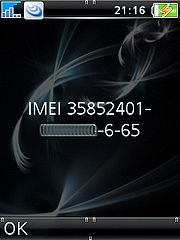- Type Approval Code
-
Die International Mobile Station Equipment Identity (IMEI)[1] ist eine eindeutige 15-stellige Seriennummer, anhand derer jedes GSM- oder UMTS-Endgerät eindeutig identifiziert werden kann.
In der breiten Öffentlichkeit ist die IMEI durch die Möglichkeit zum Sperren eines gestohlenen Mobiltelefons bei den Mobilfunknetzbetreibern bekannt. In der Theorie ist das Mobiltelefon nach Sperrung auch mit einer anderen SIM-Karte nicht benutzbar. Dazu werden die betroffenen IMEIs in Listen geführt. Weitere Details zu diesen Listen und deren mangelhafter Eignung zum Diebstahlschutz siehe unter Equipment Identity Register (EIR).
Die IMEI wird außerdem häufig benötigt um eine SIM-Lock-Sperre zu entfernen.
Inhaltsverzeichnis
Abfrage
Die IMEI eines Mobiltelefons kann mit der Tastenkombination *#06# abgefragt werden. Die IMEI sollte aufbewahrt werden, um das Endgerät im Falle eines Diebstahls der Polizei als gestohlen melden zu können. Dieser Tastencode ist einheitlich im GSM-Standard vorgeschrieben.
Bei vielen Mobiltelefonen kann man die IMEI auch auf dem Typenschild finden. Es befindet sich üblicherweise unter dem Akku.
Format
Im Laufe der Zeit wurden unterschiedliche Formate spezifiziert:
Format bis 31. Dezember 2002
Für IMEIs von Endgeräten die bis einschließlich 31. Dezember 2002 zugelassen wurden gilt das Format TTTTTT - FF - SSSSSS - C
- TTTTTT: Die ersten sechs Ziffern bilden den TAC (Type Approval Code). Die ersten zwei Ziffern des TAC weisen auf die zulassende Stelle hin. Die restlichen vier Ziffern enthalten den Zulassungscode. Der TAC ist für verschiedene Endgerätehardware eindeutig und kann zur Identifizierung eines Endgeräts herangezogen werden[2].
- FF: Die nächsten zwei Ziffern bilden den FAC (Final Assembly Code). Dieser gibt den Herstellercode des Endgerätes wieder.
- SSSSSS: Die nächsten sechs Ziffern bilden die Seriennummer SNR.
- C: Die letzte Ziffer ist die Prüfziffer CD (Check Digit). In GSM-Phase-1-Geräten ist sie '0', ab Phase 2 ist sie belegt. Die Prüfziffer wird lediglich im Gerät gespeichert, bei Übermittlung im Netz wird immer eine '0' übertragen. Der Algorithmus zur Errechnung ist dokumentiert in 3GPP TS 23.003, Anhang B[2].
Format ab 1. Januar 2003
Für IMEIs von Endgeräten die vom 1. Januar 2003 bis einschließlich 31. März 2004 zugelassen wurden gilt das Format TTTTTT - 00 - SSSSSS - C
- TTTTTT: Die ersten sechs Ziffern heißen ab jetzt Type Allocation Code[2].
- Der FAC hat für die Übergangszeit bis zur Einführung 8-stelliger TACs den Wert 00.
- Die Bedeutung der Elemente SSSSSS und C haben sich nicht verändert.
Format ab 1. April 2004
Für IMEIs von Endgeräten die ab 1. April 2004 zugelassen wurden gilt das Format TTTTTTTT - SSSSSS - C
- TTTTTTTT: Der FAC entfällt zugunsten eines jetzt 8-stelligen TAC.
- Die Bedeutung der Elemente SSSSSS und C haben sich nicht verändert.
Jedes Endgerät verfügt außerdem noch über eine zweistellige Kennung des jeweils im Gerät vorhandenen Softwarestands, die Software Version Number SVN. Diese ist nicht Bestandteil der IMEI, wird jedoch häufig bei Abfrage durch *#06# mit ausgegeben.Einzelnachweise
- ↑ http://www.3gpp.org/ftp/Specs/html-info/22016.htm 3GPP TS 22.016: International Mobile Equipment Identities (IMEI)
- ↑ a b c http://www.3gpp.org/ftp/Specs/html-info/23003.htm 33GPP TS 23.003 Numbering, addressing and identification
Weblinks
- IMEI-Analyse über International Numbering Plans
- Telefon-Identifikation für Nokia-Geräte, TAC -> Mobiltelefon
- IMEI-Generator (Generieren von Seriennummern für Nokia-Telefone)
- Telefon-Identifikation für alle Hersteller (TAC zu Telefon, Telefon zu TAC)
- Brigitte Zypries Bundesministerin für Justiz (SPD) zum Thema
- The IMEI Database (IMEI DB)
Wikimedia Foundation.

